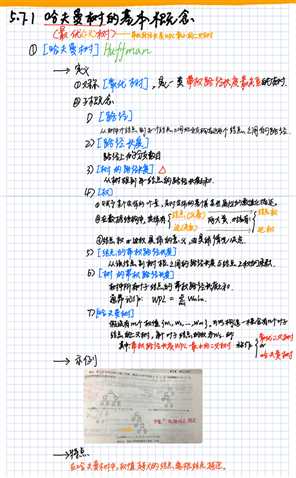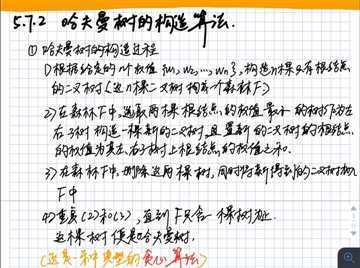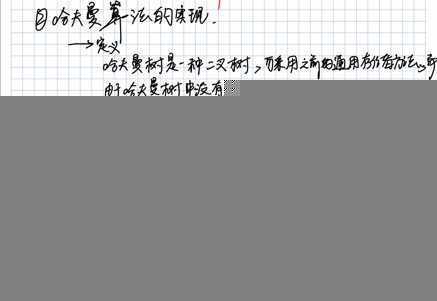[C++] 数据结构之哈夫曼树(最优满二叉树) / 哈夫曼编码
Posted johnnyzen
tags:
篇首语:本文由小常识网(cha138.com)小编为大家整理,主要介绍了[C++] 数据结构之哈夫曼树(最优满二叉树) / 哈夫曼编码相关的知识,希望对你有一定的参考价值。
一 哈夫曼树
1.1 基本概念
- 算法思想
- 定义
- 哈夫曼树 = 最优((满)二叉)树 = 带权路径之和最短的树
- 哈夫曼树所产生的哈夫曼编码 = (最优)前缀编码

1.2 算法描述/构造过程

1.3 算法实现

- 1> 定义存储结构
# define MAXNEGATIVE -9999 //最大负值
# define MAXPOSITIVE 9999 //最大正值
typedef struct HuffmanNode // 加 typedef : 避免发生编译错误 " variable or field 'functionName' declared void "
double weight;
int parent, lchild, rchild; //当前节点的双亲结点、左右孩子结点
*HuffmanTree;- 2> 确定最小的两个结点的选择策略(贪婪策略)【次核心】
/**
* 选择权值结点最小的两个结点 s1、s2
*/
void Select(HuffmanTree &HT,int k,int *s1,int *s2)
int min[2]=0, 0; // 升序排名, 保留 HT中 权重值最小的两个结点的下标
cout<<"Select k:"<<k<<endl;
HT[0].weight = MAXPOSITIVE; // 初始化为最大正值,方便被 初始结点比最小而比下去
for(int i=1;i<=k;i++)
// cout<<"i:"<<i<<"\\tweight:"<<HT[i].weight<<"\\tparent:"<<HT[i].parent<<"\\tparent.weight:"<<HT[HT[i].parent].weight<<endl;
if( HT[i].parent==0 && (HT[i].weight<HT[min[1]].weight))
if(HT[i].weight<HT[min[0]].weight) // 小于 最小者
min[1] = min[0]; min[0] = i; cout<<i<<"小于最小者!"<<endl;
else
min[1] = i;cout<<i<<"小于次小者!"<<endl; //仅小于 次小者
*s1 = min[0]; // 最小者下标
*s2 = min[1]; // 次小者下标
// cout<<"s1:"<<*s1<<"\\ts2:"<<*s2<<endl;
- 3> 创建 Huffman 树【核心】
/**
* 创建 Huffman 树
* n : 初试结点(待编码结点)数
*/
void CreateHuffmanTree(HuffmanTree &HT, int n)
int m = 2*n-1;
HT = new HuffmanNode[m+1]; // 0 位空余
cout<<"Please input initiative node's weight : "<<endl; // 输入结点数据
for(int i=1;i<=n;i++)
cin>>HT[i].weight;
for(int k=1;k<=m;k++) // 初始化所有结点
HT[k].lchild = 0;
HT[k].rchild = 0;
HT[k].parent = 0;
for(int j=n+1;j<=m;j++)
int s1,s2;
Select(HT, j-1, &s1, &s2); // 选择权值结点最小的两个结点s1、s2
HT[s1].parent = j; // 合并左右结点
HT[s2].parent = j;
HT[j].lchild = s1;
HT[j].rchild = s2;
HT[j].weight = HT[s1].weight + HT[s2].weight;
- 4> 输出哈夫曼树
void OutputHuffmanTree(HuffmanTree &HT, int n) // 输出 哈夫曼树 中 结点情况
int m = 2*n-1;
for(int i=1;i<=m;i++)
cout<<"<"<<i<<"> weight: "<<HT[i].weight<<"\\t"<<"parent: "<<HT[i].parent<<"(weight:"<<HT[HT[i].parent].weight<<")\\t";
cout<<"parent.lchild:"<<HT[HT[i].parent].lchild<<"(weight:"<<HT[HT[HT[i].parent].lchild].weight<<")"<<"\\t";
cout<<"parent.rchild:"<<HT[HT[i].parent].rchild<<"(weight:"<<HT[HT[HT[i].parent].rchild].weight<<")"<<endl;
- 5> 执行:Main函数
int main()
HuffmanTree HT;
int n;
cout<<"Please input Huffman initiative Node Number:"; // 输入哈夫曼结点初始结点数目 n
int s1, s2;
cin>>n;
CreateHuffmanTree(HT, n);
OutputHuffmanTree(HT, n);
return 0;

二 哈夫曼编码
三 哈夫曼译(解)码
四 参考文献
- 《数据结构(C语言版):严蔚敏/吴伟民》
以上是关于[C++] 数据结构之哈夫曼树(最优满二叉树) / 哈夫曼编码的主要内容,如果未能解决你的问题,请参考以下文章